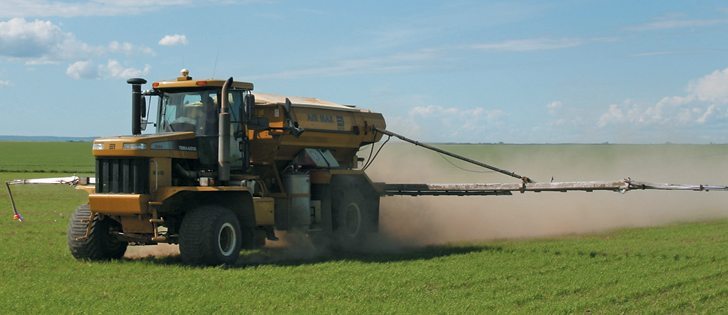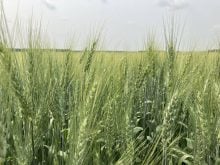Nozzles worth investment | Streaming, rather than spraying, prevents leaf burn
If it’s available, growers should apply liquid urea ammonium nitrate rather than dry urea with a urease inhibitor when top dressing, said Dave Franzen, a soil fertility expert in North Dakota.
When applied as a stream from a sprayer, UAN losses through volatilization are less than dry urea with a urease enzyme inhibitor, he said.
“Streaming, that’s my number one (option). Urea with the Agrotain (urease inhibitor) is a close number two,” said Franzen, North Dakota State University extension soil specialist.
“It depends on what the supply is. If you don’t have liquid close (to purchase)… you have to factor in the practicalities. But if everything was ready and available, my number one would be the streaming.”
Read Also

Volatile temperatures expected for this winter
DTN is forecasting a lot of temperature variability in the Canadian Prairies this winter. Precipitation should be close to average.
Growers in western Manitoba, eastern Saskatchewan and North Dakota have coped with wet conditions this spring and may not have side-banded nitrogen when they seeded the crop.
Producers in other regions may not have put all their nitrogen down because of time and logistical constraints at seeding time. Both groups of growers will likely need to top dress nitrogen this spring.
Tom Jensen, northern Great Plains director for the International Plant Nutrition Institute, agreed that UAN is the best option for growers who plan to top dress.
“Back in the old days before ammonium nitrate became such a security threat, it was the ideal product for top dressing,” he said. “Theoretically, UAN is half ammonium nitrate and half urea. Half of the nitrogen in UAN is less susceptible to (losses).”
The one drawback is that urea ammonium nitrate may not be readily available in certain areas.
If producers can buy UAN, they should add an urease inhibitor to minimize the risk of gaseous losses from the urea portion of the product, said Thom Weir, senior agronomist with Farmers Edge.
“Unless there’s imminent rain, you’d put on the Agrotain with it.”
Jensen said it’s important that the UAN is applied as a stream, rather than a spray, to prevent leaf burn.
“Once you’re over 10 pounds of nitrogen, you get a lot of leaf burn…. If you do the dribble band, you’ll see the burn where the streams (contact the plant), but you miss a lot of the leaves,” he said.
“It’s not that expensive to get the stream nozzles… it’s worth the investment.”
Franzen said urea in combination with a urease inhibitor like Agrotain is an effective second option. But growers should never apply dry urea without an inhibitor because an enzyme in the soil called urease rapidly converts the urea into ammonia gas.
“The worst thing to do is just spread urea and hope it rains.”
University of Manitoba research indicates that volatilization losses from surface applied urea can be substantial when soil temperatures are high and it is windy. At a soil temperature of 25 C, tests showed that 38 to 46 percent of urea nitrogen was converted to ammonia and lost to the air in five days.
“The worst losses for urea are when there’s a wet soil surface, it dissolves but there isn’t enough moisture to take it into the soil,” Jensen said. “If you have warm, breezy, sunny conditions… that’s when you have the highest losses.”
Jeff Schoenau, University of Sask-atchewan soil scientist, said a urease inhibitor will minimize losses for up to 14 days.
Schoenau said producers may want to broadcast slightly more urea than the target rate.
“If you anticipate some additional losses because of, you might say, an inferior application method like broadcasting, you’d need to up the rate to account for those additional losses.”
As for timing, Schoenau said producers should top dress nitrogen as soon as possible.
“For any kind of post-emergent application of nitrogen, the earlier you get it on the better in terms of recovery from yield loss.”
For canola, top dressing of nitrogen should occur before the four to six leaf stage, according to the Canola Council of Canada web-site.
Franzen said before or at the four to five leaf stage is ideal for any of the small grain crops.
















